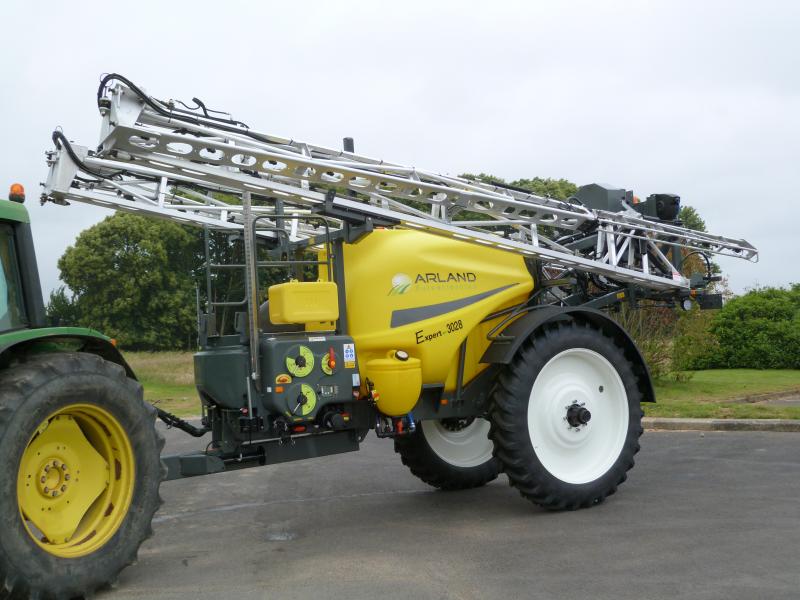Top Tips: How to Maintain Your Agricultural Sprayer
Keeping your agricultural sprayer in top condition is essential for effective crop protection. This guide covers how to maintain your agricultural sprayer with easy-to-follow tips. From choosing the right nozzles to proper storage, you’ll find everything you need to keep your equipment running smoothly.

Key Takeaways
- Selecting the right nozzles and ensuring regular cleaning are crucial for effective agricultural spraying and preventing equipment malfunction.
- Performing regular inspections and maintenance, including pump lubrication and proper storage, extends the lifespan and performance of the sprayer.
- Calibrating the sprayer for accurate application rates reduces chemical waste, minimises crop damage, and ensures uniform coverage during pesticide application.
Select the Right Nozzles and Setup
Selecting the right nozzles for your sprayer is vital for effective and uniform spraying. Spray drift can significantly impact spraying effectiveness, leading to uneven coverage and potential loss of chemicals. Ensuring nozzle compatibility with your products, speeds, and pressures guarantees that your sprayer delivers the proper amount of chemical, covering crops evenly.
Running your sprayer with clean water regularly helps assess nozzle performance and keeps spray lines free from debris, preventing clogged nozzles and uneven application. A calibration disk can also assist in selecting the appropriate nozzle and pressure for uniform coverage.
Keeping nozzles clean ensures effective pesticide application, and damaged nozzles should be replaced promptly to avoid disruptions. A proper nozzle setup is foundational for successful spray pattern spraying.
Regular Cleaning and Inspection

Cleaning and inspecting your crop sprayer regularly are essential maintenance tasks. Chemical buildup from inadequate cleaning can affect future applications and harm crops. Using a designated cleaner can effectively remove pesticide residues and debris from hoses and tanks, ensuring equipment readiness.
Letting a cleaning solution sit in the tank overnight helps remove stubborn residues. After cleaning, a final rinse with clean water ensures no harmful chemicals remain that could mix with new chemicals during the next use.
When cleaning sprayers, safety is paramount. Operators should wear personal protective equipment like gloves and goggles to avoid chemical exposure.
Inspections are equally crucial. Checking hoses and connections for leaks prevents malfunctions, and promptly replacing worn hoses or damaged parts avoids further damage to the sprayer.
Maintain the Solution System
Maintaining the solution system is vital for sprayer performance and longevity. Contamination prevention is crucial to ensure the effectiveness and safety of the sprayer. Proper cleaning prevents soil and water contamination from pesticides or chemicals, often required by legal regulations to avoid harmful residues entering water systems.
Rinsing the sprayer tank with clean water prevents contamination from previous chemicals. Before storage, rinse the entire system to remove residual chemicals, maintaining equipment integrity and readiness for use.
After cleaning, drain all components to prevent water from freezing and causing damage during colder months. Draining the tank and hoses after use avoids damage from leftover chemicals, integral to keeping your solution system in top shape.
Proper Lubrication and Protection
Lubrication and protection are essential for sprayer functionality and longevity. Preventative maintenance plays a crucial role in extending equipment life. Proper pump lubrication ensures smooth operation and extends lifespan. Applying oil after draining water prevents corrosion and keeps the pump in good condition.
Protective cover prevents dust and debris accumulation, reducing wear and tear. Inspecting for scratches and touching them up with paint prevents corrosion, keeping your equipment looking and functioning like new.
These steps are part of regular maintenance, ensuring your sprayer performs optimally. Proper care and protection extend equipment life, saving money over time.
Address Pump Maintenance
The pump is the heart of your sprayer, and its maintenance is vital for optimal performance. Pump seals are crucial in preventing leaks and ensuring the pump operates efficiently. Regular inspections for wear, damage, or leaks help identify issues before they cause pump failure.
Lubrication is essential for pump maintenance. Using high-quality lubricants provides protection against oxidation, corrosion, and rust, significantly prolonging equipment lifespan when properly lubricated.
Monitoring and analysing lubricants regularly ensure they perform effectively and help avoid potential equipment issues.
Store Your Sprayer Correctly During Off-Season
Proper off-season storage protects your sprayer from damage and ensures it is properly secured for the new season. Thorough cleaning before storage removes any harmful remaining chemicals.
A dry environment protects the sprayer from rust and moisture damage. Ideally, store it in a dry building to avoid weather-related damage. If indoor storage isn’t possible, cover the sprayer to shield it from snow and rain.
Remove, dry, and store nozzle tips and strainers in a protective environment to avoid corrosion. Cover all openings to keep out insects and debris during storage. These steps ensure your sprayer remains in good condition and ready for use.
Use Quality Parts and Accessories
Quality parts and accessories are essential for sprayer performance and reliability. OEM parts play a crucial role in ensuring compatibility and performance. They enhance functionality and ensure smooth operation. Promptly replace worn parts to avoid further complications and costly repairs.
Regular maintenance and quality components prevent breakdowns and extend sprayer lifespan. Refer to the owner’s manual for parts and accessories recommendations, ensuring replacements are compatible with your equipment. Attention to detail leads to optimal performance and longevity.
Calibrate for Accurate Application Rates
Calibrating your sprayer ensures accurate application rates. Regular calibration reduces waste, minimises crop damage, and ensures precise chemical applications. Inaccurate calibration can result in insufficient or excessive chemical application, causing detrimental effects.
Calibration involves measuring the area covered by a specific volume of spray mixture and the flow rate, allowing precise calculation of the correct amount of needed chemicals. Always perform calibration with clean water before using crop protection products.
If nozzle output deviates by more than 10% from the expected value, replace all nozzles.
Perform Regular Maintenance Routine
A regular maintenance routine is crucial for sprayer longevity and performance. A maintenance schedule plays a vital role in ensuring timely maintenance tasks. Pre-use inspections identify potential problems, ensuring the sprayer is in good condition. This involves checking nozzle compatibility, cleanliness, proper calibration, and pump lubrication.
Regular maintenance routines prevent damage, extend equipment lifespan, and ensure optimal performance. Proper care, regular cleaning, and timely replacement of worn parts are key to maintaining your sprayer.
Utilise Pressure Washers for Thorough Cleaning
Pressure washers are highly effective for thorough sprayer cleaning, removing dirt and grime that regular methods miss and protecting against corrosion when used with a detergent solution. Using a pH-neutral formula in detergents ensures surface and material safety.
Warm water enhances residue removal compared to cold water. Foam cleaning agents adhere better to surfaces, providing more effective cleaning of sprayer attachments.
Regular pressure washer cleaning efficiently maintains sprayer cleanliness and functionality.
Summary
Maintaining your agricultural sprayer is essential for its performance, longevity, and the success of your farming operations. From selecting the right nozzles and regular cleaning to proper storage and using quality parts, each step plays a vital role in ensuring your sprayer functions optimally. Regular maintenance routines, proper lubrication, and calibration for accurate application rates are key practices that cannot be overlooked.
By following these expert tips and dedicating time to proper care, you can prevent costly repairs, ensure uniform application of chemicals, and protect your investment. Remember, a well-maintained sprayer is the cornerstone of effective and efficient farming.
Frequently Asked Questions
How often should I clean my agricultural sprayer?
You should clean your agricultural sprayer after each use to prevent chemical buildup and ensure optimal performance for future applications.
What is the best way to store my sprayer during the off-season?
The best way to store your sprayer during the off-season is to keep it in a dry environment, remove and store the nozzle tips and strainers, and cover all openings to prevent insects and debris from entering. This will help ensure its longevity and effectiveness for your next use.
How do I select the right nozzle for my sprayer?
To select the right nozzle for your sprayer, consider the compatibility with the products you’ll use, along with the intended speeds and pressures. Additionally, utilising a calibration disk will help ensure uniform coverage.
What are the benefits of using a pressure washer for cleaning my sprayer?
Using a pressure washer for cleaning your sprayer ensures effective removal of dirt and grime, protects against corrosion, and enhances cleaning with warm water and foam agents. This method not only maintains equipment performance but also extends its lifespan.
Why is regular calibration important for my sprayer?
Regular calibration is essential for your sprayer as it guarantees accurate application rates, reducing waste and potential crop damage. This precision also enhances safety in chemical applications, ensuring effective pest and weed control.





